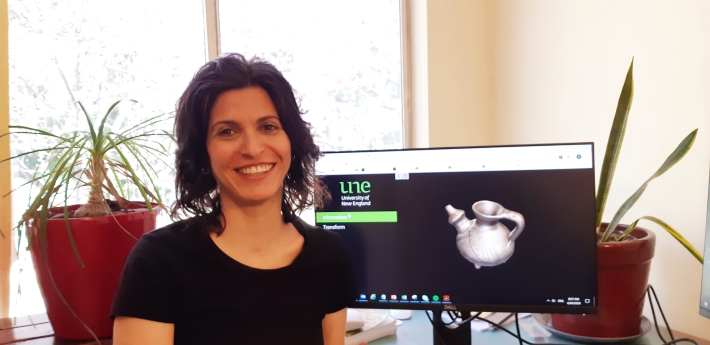There’s more than a trace of ancient life to be explored in the thousands of items in UNE’s antiquities collections, but a trace is all it would take to the view the collection in a whole new light.
“The amazing thing is that some of the microbes or pathogens that were trapped in the crevices of a vessel used for food preparation or medicine could still be there,” says UNE biomedical lecturer Dr Gal Winter.
“We could learn a lot about wild strains of yeast, for example, or the varieties of diseases around at the time.”
Curator of UNE’s Museum of Antiquities, Dr Bronwyn Hopwood, says over half the 3,000 objects in the museum had domestic and personal uses and most of the items are ceramic, making them very interesting for scientific exploration.
However, while an opportunity for microbiology students to test the objects for simple lifeforms may not be possible for these delicate 2,000 to 5,000 year old museum artefacts, Dr Winter believes there are other ways a selection of the objects, such as an ancient baby bottle and a ladle for a wine vat, could be used to enhance her students’ learning.
“People see microbiology as something separated from everyday life until it’s all over the news such as in a health crisis. But microbiology is relevant to everyday life even when it’s not in the news. Little creatures shape really big world changes!” she says.
Dr Winter said using ancient artefacts in her classes could help students make new connections between the micro and macro world and to contextualise what they’re learning.
“Microbiology has played a huge part in shaping history, particularly in food and fermentation processes.
“I’d like to introduce a research activity where students can choose an item from the collection and research the period it’s from, the use of the item and the microbes that were used then, such as in brewing and fermentation, to expand their horizons in terms of how to look at science and microbiology,” Dr Winter says.
“We might offer courses at university in different faculties and disciplines, but in real life everything is connected. I think making these connections really reinforces the students’ learning. Everything we can do to expose students to new views and the world outside textbooks is so important and can transform their learning completely.”
While it’s early days, Dr Winter is hoping to pilot the research project in the ‘Introduction to Microbiology’ unit before potentially integrating it in the Bachelor of Science.
It’s exactly the kind of collaborative project idea that Associate Director of the University Collections, Narelle Jarry, is hoping to see to get UNE’s artefacts off the shelves and utilised more often for teaching and learning.
“People find the collections we have here very compelling. And these are university collections; they’re there for everyone. Just because they sit within a particular discipline doesn’t mean they’re the only ones who can learn and benefit from them. There are so many opportunities to think creatively about using the collections we have in teaching,” she says.
Dr Hopwood says she has already been impressed with the variety of projects undergraduate and master’s students across the university have devised utilising objects in the collection to suit their own research interests.
“The diversity of the collection allows students to pursue a broad range of interests; we’ve already had undergraduate and master’s level students explore things like ancient glass-making technology and the socio-economic impact of the trade in Greek ceramics, for example. One project even analysed the zoological components of the museum’s bandicoot jaw and crab claw necklace to identify the exploitation of species in the New Guinea highlands.
“All of these projects have produced some surprising results, and it will be incredibly exciting to see what microbiological studies of the collection reveals,” Dr Hopwood says.
The collections are currently undergoing a process of digitisation, so they’ll be available for students and researchers to explore from anywhere.
“We’re in the very early days of a 3D scanning project, aiming to scan the entire 3,000-plus objects in the Museum of Antiquities collection and provide both colour and texture format scans, so the detail will be as clear, or clearer, than if you were looking at the object in the museum,” Dr Hopwood says.
“This will make it easier for researchers from any discipline to explore and access the objects and therefore will also help facilitate exciting cross-collaborative projects like Dr Winter’s project.”
Ms Jarry ultimately hopes to see the collections used beyond UNE research and classes.
“With digitisation, students can enjoy the collections online in much the same way as they could on campus, which is really important,” Ms Jarry says.
“But I don’t think it’s up to us to limit how the collections should be used. I’d like to see more of our collections digitised and go into an online and open access bank of artefacts where they can be accessed by anyone for teaching, research and outreach.”


